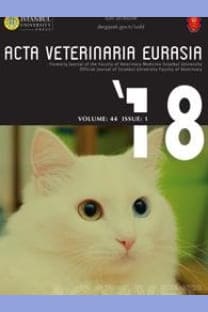İNEKLERDE GÜÇ DOĞUMA BAĞLI ŞEKİLLENEN RETENSIYO SEKUNDINARYUM'UN ENGELLENMESİNDE BETA BLOKORLERİN (CARAZOLOL) VE PGF2A'NIN ETKİLERİNİN KARŞILAŞTIRILMASI
ÖZET Bu çalışmada ekbolik etkili Beta-reseptör blokorü carazolol ile PGF2a analoglarından cloprostenol'un güç doğuma bağlı şekillenen retensiyo sekindinaryumun engellenmesi ve fertilite üzerine olan etkisi araştırıldı. Araştırmanın materyalini Türkiye Tarim İşletmeleri Genel Müdürlüğü'ne (TİGEM) bağlı Ceylanpınar Tarım İşletmesi Gökçayır Sığırcılık Şubesi'nde bulunan 2.5-9 yaşları arasında güç doğum yapmış toplam 62 baş inek oluşturmuştur. Deney hayvanlarına doğumdan hemen sonra ait olduğu gruba göre 5 mg Carazolol (Suacron®) (n=21) veya 0.50 mg Cloprostenol (Estrumate®) (n=21) ve kontrol grubuna (n=20) 10 ml serum fizyolojik, yavru zarları atılıncaya kadar, yirmi dört saat arayla (en fazla üç gün) uygulandı. İlaç uygulamalarından hemen sonra klinik muayenelerle yavru zarlarını atma süresi. retensiyo sekundinaryum oranı, metritis oluşum oranları ve involüsyonun tamamlanma süresi değerlendirildi. Çalışma sonunda carazolol grubunda yavru zarları ortalama 6.95 ± 1.38 saat, cloprostenol grubunda 9.18 ± 1.46 saat ve kontrol grubunda da 15.82 ± 2.08 saatte atıldı. Carazolol grubunda %14.2. cloprostenol grubunda %38.0 ve kontrol grubunda %55 oranında retensiyo sekundinaryum şekillendi. Yavru zarlarının atılma süresi ve retensiyo sekundinaryum şekillenenlerin oranı açısından gruplar arasındaki fark önemli bulundu (p<0.05). Metritisler ise sırasıyla %20, %28.5 ve %45 olarak şekillendi. Bu parametreye göre gruplar arasındaki fark önemli bulunmadı (p>0.05). . Haftada bir yapılan rektal muayene bulgularına göre uterus involüsyonu carazolol grubunda 41.0 ± 3.26 gün, cloprostenol grubunda 47.5 ± 1.96 gün ve kontrol grubunda 58.9 ± 3.76 günde tamamlandı. İnvolüsyonun tamamlanma süresi açısından carazolol ile cloprostenol gruplarının kontrol grubuna göre farkı istatistiksel olarak önemli bulunmuştur (p<0.001). Çalışma sonunda; güç doğum yapan ineklerde doğumu takiben yavru zarlarının atılması, retensiyo sekundinaryum oranının azaltılması, metritislerin azaltılması ve involüsyon süresinin kısaltılması amacıyla doğum sonrası beta reseptör blokör etkili carazolol uygulamasının faydalı olacağı kanısına varılmıştır. Anahtar kelimeler: Güç doğum, Retensiyo sekundinaryum, Carazolol. Cloprostenol COMPARISION OF THE BETA RECEPTOR BLOCKERS (CARAZOLOL) AND PGF2A TO PREVENT THE RETAINED PLACENTA IN COWS DUE TO DYSTOCIA ABSTRACT In this study the effects of beta receptor blockers (carazolol) and an analogue of PGF2a (cloprostenol) on the prevention of retained placenta and the fertility in cows with dystocia were investigated. The study was conducted at the Gok9ayir dairy farm branch of Ceylanpınar Tarım işletmesi affiliated to Turkish Agriculture Ministry (TIGEM). Sixty-two cows with dystocia, aged between 2.5-9 years were used. Just after parturition, according to the group in which the animal is belonging to 5 mg carazolol (Suacron©, Bayer) (n-21) or 0.50 mg cloprostenol (Estrumate®. DIF) (n=21) and to the control group (n=20) 10 ml placebo is administrated by 24 hours interval until the expulsion of the fetal membranes (at most 3 days). After the drug administrations, the time of the expulsion of fetal membranes, the retained placenta rate, metritis and involution rate is evaluated by clinical examinations. At the end of the study, the expulsion of the fetal membranes occurred in carazolol group about 6.95 ± 1.38 hours, in cloprostenol group about 9.18 ± 1.46 hours and about 15.82 ± 2.08 hours in control group. The retained placenta is occurred by the rate of 14.2% in carazolol group, 38.0% in cloprostenol group and 55% in control group. From the point of view the time of the expulsion of fetal membranes and the rate of occurrence of retained placenta of all groups have important differences (p<0.05). The rate of saving by hand in the cows which retained placenta observed is found 9.5% in carazolol group, 19% in cloprostenol group and 15% in placebo group. Observation of the metritis rate occurred 20% in carazolol group, 28.5% in cloprostenol group and 45% in control groups. From the point of view of this property the difference of between the groups is found unimportant (p>0.05). According to the finding by the rectal examinations that had maken once in a week in carazolol group 41.0 ± 3.26 days, in cloprostenol group 47.5 ± 1.96 days and in control group 58.9 ± 3.76 days involutions had been completed respectively. The carazolol and cloprostenol groups have differences with the control group according to the time of involution completing (p<0.001). At the end of the study, the administrations of p-receptor blockers carazolol and PGF2a in cows after dystocia was found effective in decreasing the incidence of retained placenta, decreasing metritis and shortening the involution time Keywords: Dystocia, Retained placenta, Carazolol. Cloprostenol
